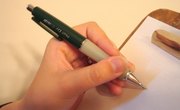As adults, we often use figures of speech in our daily vernacular and think nothing of it, but to a child, these figures of speech may be confusing. When a child hears a figure of speech, such as "It's raining cats and dogs," she may become confused when she looks outside and does not see cats and dogs falling from the sky. When teaching children figures of speech, highlight both the literal and figurative forms of the phrase to help them understand that these phrases do not make much sense when thought of in a literal context.
Discuss figurative language with children. Explain that people use figures of speech to exaggerate or to create interesting conversation.
Provide examples of different types of figures of speech. Examples of figures of speech to consider include "fast as lightning," "cold as ice" and "eat like a horse."
Ask children to explain what the statements may mean in a real or literal sense. Explain to children that when the statements are thought of literally, they do not make much sense. For example, people cannot really be fast as lightning, but they can be really fast. However, although someone cannot be fast as lightning, a sentence that contains such a phrase sounds more interesting than a sentence that simply says, "He runs really fast."
Write a figure of speech on the bottom of a piece of construction paper; one for each child. Distribute the papers to students. Have children read the phrases and ask them if they can guess what the figures of speech mean. Provide clarification if needed.
Instruct children to divide their papers in half. Have them draw a picture that illustrates the literal meaning of the figure of speech on one half of the paper. On the other half of the paper, instruct children to draw a picture that illustrates the figurative meaning of the phrase. For example, a student who has the statement, "cold as ice" may draw a picture of ice cubes for the literal meaning of the phrase and a picture of someone who is not nice for the figurative meaning.
Related Articles
References
Writer Bio
Lily Mae began freelance writing in 2008. She is a certified elementary and literacy educator who has been working in education since 2003. Mae is also an avid gardener, decorator and craft maker. She holds a Bachelor of Arts in education and a Master of Science in literacy education from Long Island University.











